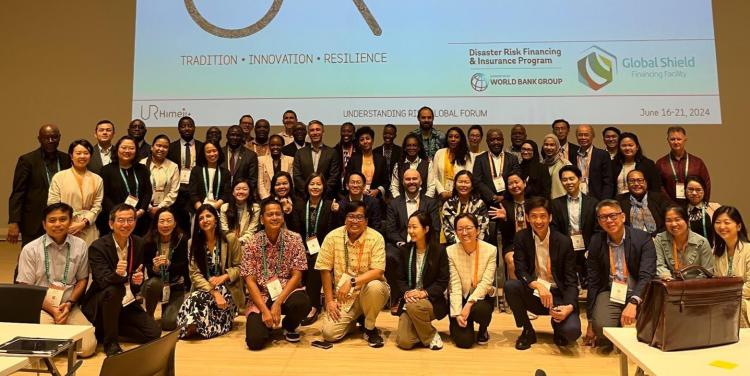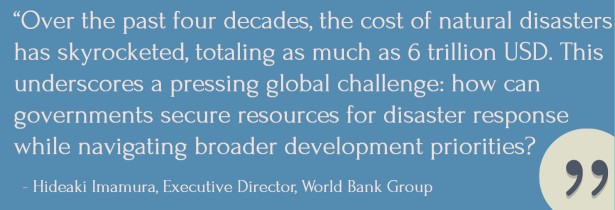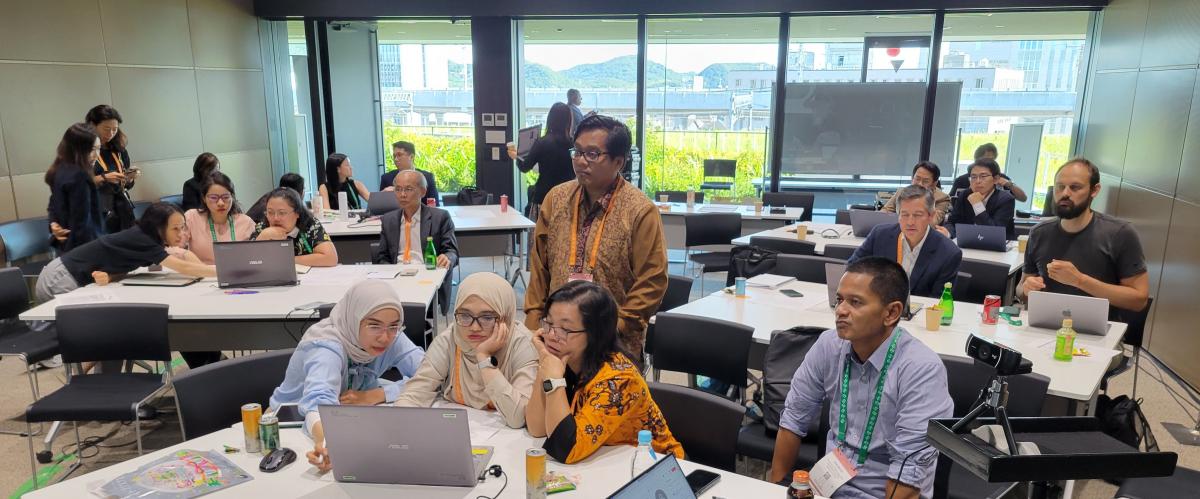Strengthening Financial Resilience against Climate and Disaster Impacts: Key Insights from UR24

A joint reflection note by the World Bank’s Disaster Risk Financing and Insurance Program (DRFIP), Global Facility for Disaster Reduction and Recovery (GFDRR), Tokyo Disaster Risk Management Hub, and Southeast Asia Disaster Risk Insurance Facility (SEADRIF) on driving innovation in disaster risk solutions for a more secure future.
The Challenge
As natural disasters continue to escalate, governments and businesses around the world must brace themselves for their financial and economic impacts. Extreme natural disasters cost an average of $452 billion annually in economic losses. Governments are investing roughly $1 trillion annually into infrastructure, yet disaster-related impact to infrastructures presents a significant part of governments’ contingent liabilities.

Effective disaster risk financing and insurance (DRFI) is a critical tool in mitigating financial losses from the impacts of climate change and natural hazards. It encourages risk-based decision-making and the adoption of financial protection instruments, and builds more resilient systems for response and recovery.
World Bank Group’s Efforts in DRFI
The World Bank Group (WBG) supports client countries in developing and most importantly implementing robust DRFI strategies to enhance their resilience through the Disaster Risk Finance and Insurance Program, in collaboration with Global Facility for Disaster Reduction and Recovery (GFDRR) Japan-World Bank Program for Mainstreaming Disaster Risk Management in Developing Countries.
The Understanding Risk Global Forum 2024 (UR24)—organized by the GFDRR Tokyo Disaster Risk Management (DRM) Hub—has been the largest Understanding Risk Global Forum to date, with more than 1,700 attendees joining onsite in Himeji, Japan in June 2024. At UR24, leading experts discussed the latest in DRFI, focusing on innovations and strategies to advance global efforts in disaster and climate resilience. Here are some key insights on the frontiers of DRFI from the event, which can help global leaders and practitioners further advance their efforts.
1. Comprehensive financial protection strategies are needed to help countries close the protection gap and strengthen holistic resilience including in the infrastructure sector.
At the “Global Knowledge Exchange on DRFI for Resilient Infrastructure” session hosted by the WBG, in partnership with Asia-Pacific Economic Cooperation (APEC), Association of Southeast Asian Nations (ASEAN)+3 and Southeast Asia Disaster Risk Insurance Facility (SEADRIF), experts shared the latest approaches in integrating disaster risk considerations into asset management frameworks, especially for lifeline critical infrastructure, such as school buildings, health facilities, transport networks, and power systems.
- In Grenada, the disaster resilience strategy has evolved since the devastating impact of Hurricane Ivan in 2004. The country now has multiple layers of financial protection, including a contingency fund, a WBG facility, and insurance with the Caribbean Catastrophic Risk Insurance Facility (CCRIF).
- Morocco’s national strategy, which includes a solidarity fund supported by insurance premiums and a risk transfer strategy for major disasters like earthquakes, has been effective in providing quick payouts after events like the Al Haouz earthquake.
- The Philippines’ DRFI strategy, which includes risk retention mechanisms like national disaster funds and risk transfer mechanisms such as parametric insurance and catastrophe bonds, have been crucial in providing quick financial support during disasters. The country’s National Asset Registry System (NARS), a consolidated database of “non-financial critical and strategically important government assets”, enables long-term sustainable asset management through efficient financial risk management that enhances service delivery, and improves risk reduction for sustainability. Utilizing NARS, more than 130,000 schools are covered through the National Indemnity Insurance Program against fire and natural catastrophes.
- In the Marshall Islands, efforts are ongoing to modernize DRFI legislation, establish contingency funds, and seek international partnerships to enhance financial resilience.
- The Japan International Cooperation Agency highlighted the importance of combining disaster risk reduction with DRFI to invest in resilient infrastructure, presenting a case for integrated approaches to resilience building and stressed on the need for strong governance and institutional frameworks to support these initiatives.
- In line with its DRFI Strategy, Indonesia has embarked on a journey to establish its State Asset Insurance program as part of its risk transfer mechanisms for public assets. The program offers 10% of all insurable office, health and educational buildings with coverage against perils including fire, floods and earthquakes.

Participants gaining a better understanding of the EEPA Tool. Photo: World Bank
2. Pre-arranged finance for public assets plays a crucial role in managing governments' disaster-related contingent liabilities.
- Linking financial preparedness with operational preparedness is crucial for building comprehensive disaster resilience, particularly in the context of public asset protection.
- Effective management of public assets involves assessing risks, ensuring resilience, and planning for contingencies. This approach not only safeguards critical infrastructure but also enhances overall disaster preparedness and response capabilities.
- The WBG is renewing its approach to knowledge, ensuring that the best global knowledge can help drive development, create scalable, replicable projects, and influence global conversations. As part of the WBG’s Knowledge Compact, a series of WBG resources like the “Financial Protection for Public Assets: A Practitioner's Guide for Public Officials (2022)”, Financial Protection of Critical Infrastructure Services (2021)”, “Catastrophe Insurance Programs for Public Assets: Operational Framework (2020)” , and a simulation-based e-learning program on DRF provide practitioners with a comprehensive knowledge base for understanding financial protection measures. Analytical tools such as WBG's Enabling Environment and Progress Assessment (EEPA) tool enable governments and stakeholders to make informed decisions regarding DRFI, asset management, and resilience-building initiatives.
3. Risk pools are a promising solution to help address the ever-widening insurance protection gap.
By aggregating risks across multiple countries in one region, regional risk pools, now available in the Caribbean, Africa, Pacific and Southeast Asia, enable countries to diversify their financial buffers and absorb shocks more effectively. However, there are challenges associated with designing innovative financing structures and ensuring sustainable implementation of risk pooling solutions. Dialogue between countries, regional risk pools, reinsurers, brokers, technology providers and development partners is crucial to foster an understanding of diverse perspectives, needs, and roles.
- Delegates from Grenada, a member of CCRIF SPC (formerly the Caribbean Catastrophe Risk Insurance Facility) -, shared their journey with their catastrophe insurance policy. While it hadn't been triggered since its inception in 2007 the government continued to purchase the policy to ensure protection. Training provided by CCRIF SPC has enabled a shift from reliance on immediate assistance to a focus on risk management and resilience. In July 2024, Grenada received multiple payouts related to Tropical Cyclone Beryl from the CCRIF SPC including to their electric and water utilities. The total payout amounted to more than $50 million, demonstrating the real proof of the value of continued protection through disaster risk financing mechanisms.
- Delegates from St. Vincent and the Grenadines, Malawi, Tonga and Lao PDR shared their experiences of engaging stakeholders across ministry and local governments in tailoring insurance products to meet their unique needs.
- Regional risk pools offer significant benefits by reducing transaction costs, accessing centralized expertise, decreasing total premium costs through economies of scale, and diversifying risk. As regional sovereign risk insurance providers, CCRIF SPC, African Risk Capacity Limited (ARC Ltd.), Pacific Catastrophe Risk Insurance Company (PCRIC), and SEADRIF indicated that the design of business models to ensure sustainability, as well as ways of securing support for capital, premium subsidy, and technical assistance are areas requiring continuous improvement.
- Many countries in Southeast Asia face significant exposure to climate and disaster risks; however, the diversification of risk across these countries offers opportunities for more efficient financial protection. SEADRIF highlighted that a potential structure for joint protection against earthquakes could result in premiums being approximately 16% lower compared to countries purchasing coverage individually, purely due to the benefits of risk diversification. By creating a larger, more diversified portfolio and taking a collective approach to the insurance market, even greater savings could be realized, with estimated overall price reductions of up to 25%.

Participants at the Risk Pools session. Photo: World Bank
4. Data and analytics are crucial for enhancing risk assessment across all phases of disasters, including accurate risk evaluation, rapid response, and damage assessment.
However, challenges persist, such as data availability in low-to-middle income countries, alongside emerging opportunities facilitated by advancements in AI and open data platforms.
- In Morocco, satellite data and machine learning have been leveraged to minimize basis risks, allowing for parametric insurance, and actuarial modeling allows for quantification of the opportunity costs between diverse risk financing instruments. In the aftermath of the Al Haouz Earthquake in September 2023, the public mechanisms unlocked US$300 million and the losses were covered fully by risk pooling.
- Insights from Nanyang Technological University included those on the ASEAN Disaster Risk Financing and Insurance Phase 2 (ADRFI-2) platform which, in addition to making accessible hazard assessments for earthquake, flood and tropical cyclones, offers national and regional exposure, including exposure by-building utilizing high-resolution satellite imagery. Critical risk metrics for DRFI instrument design such as loss exceedances from Annual Average Loss to Probable Maximum Loss are also made available.
Many organizations are involved in the implementation of data and analytics for public benefit, but there is often limited coordination or exchange of information across stakeholders. Participants representing governments, regional risk pools, development institutions, academia, reinsurers, brokers, and technology providers all agreed that greater transparency is necessary in knowledge and information exchange to facilitate collaboration across organizations and regions in an effort to share best practices and common pitfalls.
5. Partnership and capacity building
Strengthening financial protection requires robust partnership at the local, regional and global levels to maximize reach, scale and impact. Comprehensive and effective DRFI strategies can be developed and implemented by leveraging the strengths and expertise of various stakeholders, including governments, international organizations, academia, think tanks, private sector entities, and civil society organizations. Partnerships ensure that DRFI approaches are not only robust but also contextually relevant, addressing the specific needs and challenges of different regions and communities. They foster innovation, resource mobilization, and knowledge sharing.
- APEC, ASEAN+3 and SEADRIF are examples of how regional-level partnerships can advance DRFI through enhancing regional cooperation and dialogue, pooling resources and expertise, strengthening financial resilience, and capacity building and knowledge sharing.
- Academia, such as Nanyang Technological University, and think tanks like the Global Asia Insurance Partnership (GAIP), bring specialized research and technical expertise to the development of innovative DRFI strategies, contributing to informed policy-making and the advancement of financial protection mechanisms.
- Japan has shown global leadership in elevating DRFI to the forefront of the development agenda. The Japan-World Bank Program for Mainstreaming Disaster Resilience in Developing Countries, managed by the Tokyo DRM Hub, has been supporting policy dialogues on DRFI in global and regional forums. DRFI in-country capacity building engagements supported by the Japan-World Bank Program have been instrumental in the design and implementation of risk financing strategies that help countries and regions better manage disaster risks, and safeguard critical infrastructure and public/private assets. Such activities have helped to develop the baseline for strategic plans for DRFI in Southeast Asia and the Pacific, provide an understanding of the enabling environment for DRFI in South Asia, and assess disaster related contingent liabilities in Latin America.
- Global partnerships also play a significant role in strengthening financial protection, and coordination between programs is essential to meet the increasing needs of client countries. The Risk Finance Umbrella (RFU) Program, which is managed by the World Bank and supported by key donors such as the Foreign Commonwealth and Development Office (FCDO), Swiss Secretariat for Economic Affairs (SECO), and the United States Agency for International Development (USAID), consolidates analytical and advisory activities to bolster financial resilience in low- and middle-income countries. The Global Shield Financing Facility (GSFF), which evolved from the Global Risk Finance Facility (GRiF) strengthens the financial resilience of countries and people by enabling design and implementation of financial solutions. The US$415m program financed by Canada, Germany, Luxembourg, UK, and Japan, complements the RFU and works downstream to co-finance World Bank lending Programs to put in place financial solutions, but also undertakes delivery of global engagements where there are knowledge and capacity gaps in the DRF landscape. As the global risk financing landscape evolves, together, the GSFF and RFU exemplify the importance of partnerships in achieving sustainable disaster risk financing.
The role of the private sector is critical in co-financing the cost of natural disasters and making risk transfer options available. Public sector stakeholders are increasingly tapping into private sector expertise to develop ways of managing their financial exposure to disaster risks. To strengthen this collaboration, communication and trust-building, as well as improving the volume and quality of data such as on hazard risks and assets is crucial.
- The Insurance Development Forum (IDF), represented by Tokio Marine, highlighted the importance of constantly upgrading risk assessment capabilities by showcasing successful partnerships between public and private sector stakeholders in Japan's high-speed rail and offshore wind power projects.. This helps refine the allocation of risk bearing among relevant stakeholders.
Understanding complex risk financing concepts and insurance models can be challenging. During discussions at UR24, risk pools and their member countries emphasized the vital role of training, knowledge exchange, and effective communication to underscore the significance of insurance among diverse stakeholders and member countries.
To conclude, Global forums such as the Understanding Risk 2024 underscore the importance of robust disaster risk financing and insurance strategies in building financial resilience against climate and disaster impacts. By sharing innovative approaches and successful case studies, global leaders and practitioners can better navigate the complex disaster risk finance landscape and select options that are best suited for their needs. The WBG’s support in fostering regional partnerships, expanding the DRFI knowledge base, and leveraging data analytics remains vital in closing the financial protection gap amid more intense and frequent natural hazards.
